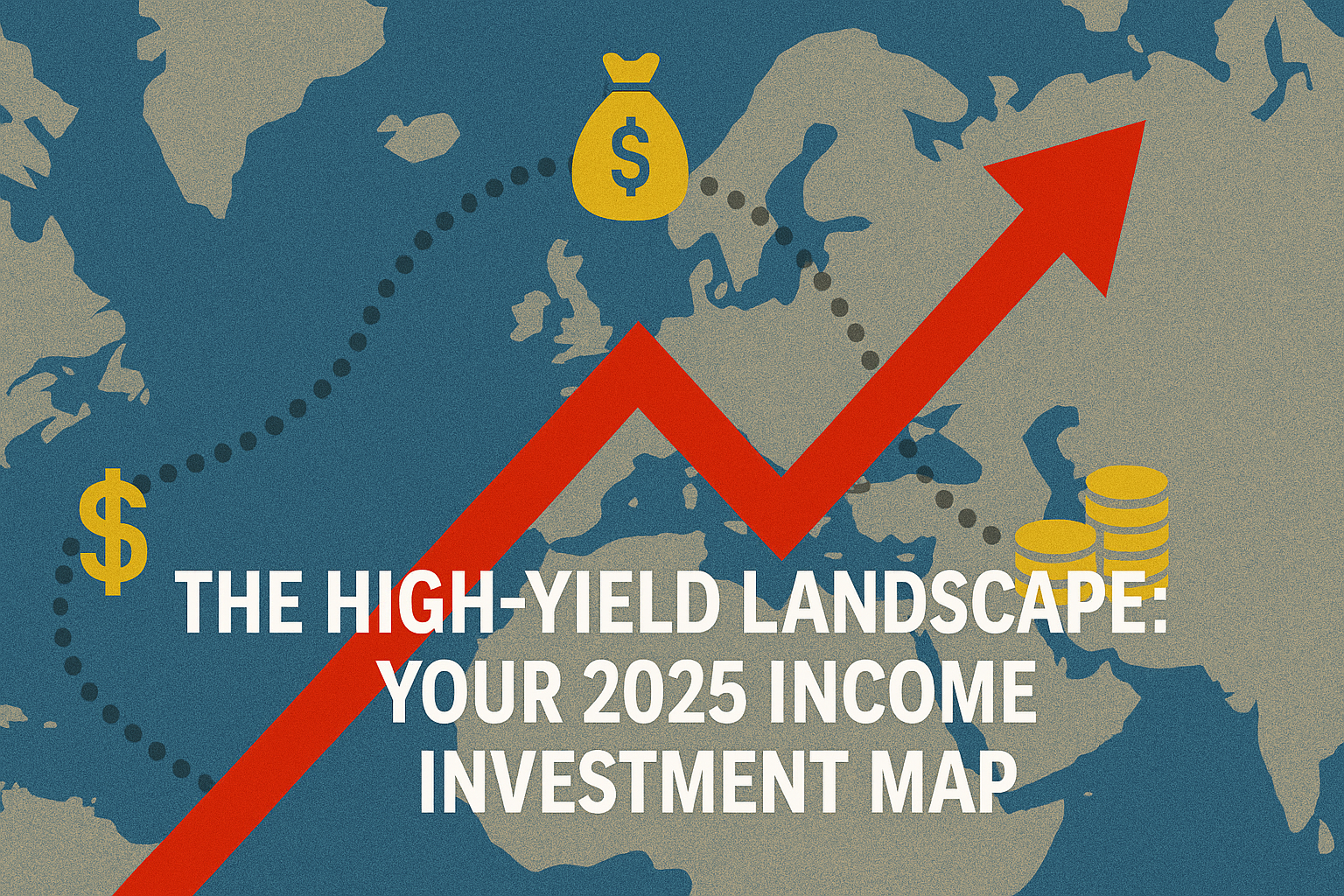While savings accounts offer 4-5%, smart income investors are capturing 6-12% yields—here’s your roadmap to the opportunities that banks don’t want you to know about.
The Great Yield Awakening of 2025
Something remarkable has happened in financial markets. After nearly 15 years of near-zero interest rates, we’re living through what I call “The Great Yield Awakening.” The Bank of England base rate stands at 4.25%, yet savvy investors are systematically capturing yields that make traditional savings accounts look like financial relics.
But here’s what most retail investors don’t realize: this higher rate environment has created a perfect storm of opportunity across multiple asset classes. While your bank celebrates offering 4.5% on cash ISAs, dividend-focused investors are building portfolios yielding 6-9% with considerably more upside potential.
The catch? You need to know where to look and how to evaluate what you find. This comprehensive guide will transform you from a yield-seeker into a strategic income investor.
Section 1: The Current Yield Environment – A Geographic Deep Dive
United Kingdom: Post-Brexit Dividend Renaissance
The UK market presents a fascinating paradox for income investors. The biggest 100 companies in the UK are expected to pay out £78.6bn in 2024 and £83.9bn in 2025, representing robust dividend growth despite economic uncertainties.
Key UK Yield Characteristics:
- FTSE 100 Average Dividend Yield: 3.8-4.2% (significantly above historical norms)
- High-Yield Opportunities: Individual stocks offering 6.4% to 10% yields are readily available
- Currency Advantage: No foreign exchange risk for UK-based investors
- Tax Efficiency: Full utilization of ISA allowances without withholding tax complications
Standout Sectors:
- Insurance Companies: Offering an impressive 9.4% annual payout on an equal-weighted basis
- Utilities and Infrastructure: Defensive characteristics with regulated revenue streams
- Energy and Resources: Benefiting from elevated commodity prices and cash generation
UK Market Reality Check: What makes UK yields particularly attractive right now is the combination of depressed valuations and strong cash generation. Many FTSE 100 companies are trading at significant discounts to their international peers while maintaining or growing their dividend payments. This creates an unusual situation where you can capture high current yields with potential capital appreciation upside.
United States: The Dividend Growth Machine
The US market operates on a fundamentally different dividend philosophy than the UK. While the S&P 500’s current dividend yield sits at just 1.27%, this headline figure masks extraordinary opportunities in dividend-focused strategies.
US Market Characteristics:
- S&P 500 Broad Market Yield: 1.27% (but this tells only part of the story)
- High-Dividend Focused Strategies: 4-8% yields through selective stock picking
- Dividend Growth Culture: Energy sector stocks averaging 3% yields, double the broad market
- Market Depth: Unparalleled liquidity and sector diversification
The US Advantage Framework:
- Dividend Aristocrats: Companies with 25+ years of consecutive dividend increases
- Sector Concentration: Utilities, REITs, and energy offering substantially higher yields
- Market Cap Efficiency: Mid-cap dividend stocks often offer better yield/growth combinations
- Currency Strength: USD strength provides additional returns for international investors
Tax Considerations for UK Investors:
- US withholding tax reduced to 15% under UK-US tax treaty
- W-8BEN form essential for treaty benefits
- Consider US-domiciled funds vs. individual stock holdings for efficiency
European Union: The Undervalued Dividend Haven
European dividend investing represents one of the most overlooked opportunities in today’s market. The combination of attractive valuations, strong cash flows, and improving shareholder return policies creates compelling opportunities.
EU Market Characteristics:
- Average Dividend Yields: 3.5-5.5% across major indices
- Currency Considerations: EUR/GBP fluctuations can enhance or detract from returns
- Regulatory Environment: Increasingly shareholder-friendly policies
- Sector Strengths: Industrial, luxury goods, and financial services leadership
Geographic Hotspots:
- Germany: Industrial powerhouses with consistent dividend policies
- Netherlands: Strong dividend culture and favorable tax treaties
- France: Luxury goods and utilities offering premium yields
- Switzerland: Defensive characteristics and currency stability
Section 2: Comprehensive Asset Class Yield Analysis
The Complete Yield Spectrum Table
| Asset Class | UK Range | US Range | EU Range | Risk Level | Liquidity | Tax Efficiency |
|---|---|---|---|---|---|---|
| High-Dividend Stocks | 4.5-12% | 3.5-9% | 4-8.5% | Medium-High | High | Variable |
| Dividend ETFs | 3.5-7% | 2.5-6% | 3-6.5% | Medium | Very High | High |
| REITs | 3.5-8% | 3-7% | 3.5-6.5% | Medium | High | Complex |
| Corporate Bonds | 4-9% | 4.5-10% | 3.5-7.5% | Low-Medium | Medium | Simple |
| Government Bonds | 3.5-4.5% | 4-5.5% | 2.5-4% | Low | Very High | Simple |
| Infrastructure Funds | 4-7% | 4.5-8% | 4-6.5% | Medium | Low | Complex |
| Utility Stocks | 4-6.5% | 3.5-6% | 3.5-5.5% | Low-Medium | High | Variable |
| Energy MLPs/Trusts | 6-12% | 7-15% | 5-10% | High | Medium | Very Complex |
Deep Dive: Understanding Risk-Adjusted Returns
The Yield Trap Warning System: Not all high yields are created equal. Here’s my systematic approach to evaluating whether a high yield represents opportunity or danger:
Green Flag Indicators (Safe High Yields):
- Payout ratio below 70% for most sectors (utilities can go higher)
- Free cash flow coverage ratio above 1.5x
- Consistent or growing revenues over 3-year period
- Strong balance sheet with manageable debt levels
- Defensive sector characteristics or market-leading positions
Yellow Flag Indicators (Proceed with Caution):
- Payout ratios between 70-85%
- Cyclical businesses at peak earnings
- Recent dividend cuts by industry peers
- High correlation to commodity prices or economic cycles
- Significant regulatory or technological disruption risks
Red Flag Indicators (Likely Yield Traps):
- Payout ratios above 90% (excluding REITs)
- Declining revenues with maintained dividends
- Debt-to-equity ratios above industry norms
- Recent management changes or strategic pivots
- Trading at 52-week lows with deteriorating fundamentals
Section 3: The Strategic Yield Framework
Portfolio Construction Philosophy
The Three-Tier Yield Strategy:
Tier 1: Foundation (40-50% of income allocation)
- Government bonds and high-grade corporate debt
- Dividend aristocrats and established blue-chip stocks
- Broad-market dividend ETFs
- Target yield: 3.5-5.5%
- Risk level: Low to medium
- Purpose: Stability and reliable income
Tier 2: Growth Income (35-45% of income allocation)
- High-quality dividend growth stocks
- Sector-specific dividend ETFs
- REITs and infrastructure investments
- Target yield: 5-7.5%
- Risk level: Medium
- Purpose: Income growth and moderate capital appreciation
Tier 3: Opportunistic (10-20% of income allocation)
- High-yield turnaround situations
- Emerging market dividend stocks
- Alternative investments (MLPs, BDCs)
- Target yield: 7-12%+
- Risk level: High
- Purpose: Enhanced yield and potential alpha generation
Geographic Allocation Framework
The Home Bias Optimization Model:
For UK-based investors, I recommend this geographic allocation:
50% UK Allocation (Home Bias with Purpose):
- Currency matching for GBP-denominated expenses
- Tax efficiency through ISA utilization
- Regulatory familiarity and easier monitoring
- Lower transaction costs and settlement risks
30% US Allocation (Growth and Depth):
- Access to world’s deepest dividend market
- Dividend growth culture and aristocrat opportunities
- Technology and healthcare sector leadership
- USD strength potential benefits
15% Other Developed Markets (Diversification):
- European industrial and luxury goods leadership
- Canadian resource and financial sector strength
- Australian dividend imputation benefits
- Japanese improving shareholder returns
5% Emerging Markets (Growth Potential):
- Higher economic growth rates
- Commodity exposure and inflation hedging
- Currency appreciation potential
- Demographic dividend opportunities
Section 4: Market Timing and Economic Cycle Considerations
Interest Rate Environment Impact Analysis
How Rising Rates Affect Different Asset Classes:
Positive Impact (Rate Rise Winners):
- Financial Sector Stocks: Banks and insurance companies benefit from higher net interest margins
- Floating Rate Instruments: Variable rate bonds and loans increase payments
- Short-Duration Bonds: Less price sensitivity to rate changes
- Value Stocks: Often higher dividend yields become more attractive vs. growth
Negative Impact (Rate Rise Losers):
- Long-Duration Bonds: Price declines as rates rise
- Utility Stocks: Higher discount rates reduce present value of future cash flows
- REITs: Higher borrowing costs and alternative yield competition
- High-Dividend Stocks: May underperform if yields don’t keep pace with bonds
Neutral/Complex Impact:
- International Stocks: Currency effects can offset or amplify rate impacts
- Commodity Stocks: Rate impacts often overwhelmed by commodity price movements
- Infrastructure Assets: Regulated returns may provide some protection
Inflation Hedge Characteristics
Natural Inflation Hedges:
- Resource Stocks: Oil, gas, mining companies benefit from commodity price increases
- Infrastructure Assets: Many have inflation-linked revenue adjustments
- Real Estate: Property values and rents typically rise with inflation
- Consumer Staples: Pricing power allows margin protection
Inflation-Sensitive Assets:
- Fixed-Rate Bonds: Purchasing power erosion of fixed payments
- Utilities: Regulated returns may lag inflation adjustments
- High-Dividend Stocks: If dividends don’t grow with inflation
Section 5: Practical Implementation Strategy
Month-by-Month Implementation Plan
Month 1: Foundation Building
- Open and fund ISA accounts for tax-efficient investing
- Research and select 2-3 broad-market dividend ETFs
- Establish emergency fund in high-yield savings (separate from investment portfolio)
- Set up systematic investment plan
Month 2: Core Holdings Selection
- Screen for dividend aristocrats in UK and US markets
- Research 5-8 individual high-quality dividend stocks
- Evaluate REIT allocation through individual stocks vs. ETFs
- Begin position building in foundation assets
Month 3: Diversification and Optimization
- Add international developed market exposure
- Implement currency hedging strategy if desired
- Review and optimize tax efficiency
- Establish monitoring and rebalancing schedule
Month 4: Opportunistic Additions
- Research higher-yield opportunities in quality companies
- Consider emerging market dividend exposure
- Evaluate alternative income investments
- Fine-tune geographic and sector allocation
Essential Tools and Resources
Free Research Tools:
- Morningstar.co.uk: Comprehensive stock and fund analysis
- Yahoo Finance: Real-time data and basic screening
- Companies House: UK company filings and financial statements
- SEC.gov: US company filings and 10-K reports
Premium Tools (Worth the Investment):
- Financial Times: In-depth market analysis and data
- Bloomberg Terminal Access: Professional-grade research (expensive but comprehensive)
- Dividend.com: Specialized dividend analysis and screening
- Seeking Alpha: Crowd-sourced research and analysis
Broker Selection Criteria:
- ISA and SIPP availability: Essential for tax efficiency
- International market access: US and European stock availability
- Dividend reinvestment options: Automatic vs. manual reinvestment
- Research tools and data: Built-in screening and analysis
- Cost structure: Per-trade vs. percentage-based fees
Section 6: Risk Management and Portfolio Protection
The Five-Factor Risk Assessment Model
Factor 1: Concentration Risk
- No single stock >5% of total portfolio
- No single sector >25% of income allocation
- No single country >60% of total holdings (including home bias)
- No single asset class >50% of income portfolio
Factor 2: Duration and Interest Rate Risk
- Average bond duration 3-7 years in normal rate environment
- Mix of short, medium, and long-term rate exposures
- Consider floating rate options in rising rate periods
- Monitor correlation between stocks and bonds
Factor 3: Currency Risk
- Understand natural hedging through international revenues
- Consider currency-hedged funds for large international allocations
- Monitor correlation between currency movements and stock performance
- Evaluate periodic rebalancing to manage currency exposure
Factor 4: Liquidity Risk
- Maintain 80%+ of holdings in daily-liquid securities
- Limit alternative investments to 10-15% of total portfolio
- Ensure ability to raise cash within 1-3 business days
- Consider market stress scenarios for liquidity planning
Factor 5: Inflation Risk
- Include inflation-hedged assets (resources, real estate, infrastructure)
- Monitor real (inflation-adjusted) yield trends
- Consider Treasury Inflation-Protected Securities (TIPS) or UK index-linked gilts
- Evaluate dividend growth rates vs. inflation trends
Stress Testing Your Income Portfolio
Scenario 1: 2008-Style Financial Crisis
- Model 30-40% decline in stock values
- Assume 10-20% dividend cuts across holdings
- Test liquidity needs and forced selling scenarios
- Evaluate correlation breakdown between asset classes
Scenario 2: 1970s-Style Inflation Surge
- Model sustained 6-8% annual inflation
- Test real return maintenance across holdings
- Evaluate fixed-income purchasing power erosion
- Consider commodity and resource stock performance
Scenario 3: Technology-Driven Sector Disruption
- Model obsolescence risk in traditional dividend sectors
- Evaluate adaptation strategies for utilities, telecoms, energy
- Consider technology dividend stock integration
- Test portfolio resilience to structural economic changes
Action Items: Your Next Steps
Immediate Actions (This Week):
- Calculate Your Required Yield: Determine what annual income you need from investments
- Assess Current Holdings: Use the risk assessment framework on existing positions
- Open Tax-Efficient Accounts: Ensure ISA and SIPP access for optimal tax treatment
- Download Research Tools: Set up free accounts with recommended research platforms
Short-Term Actions (Next Month):
- Build Your Watchlist: Identify 10-15 high-quality dividend stocks for further research
- Screen for Opportunities: Use provided criteria to evaluate current market opportunities
- Establish Systematic Investment: Set up regular monthly investments to dollar-cost average
- Create Monitoring System: Develop spreadsheet or use tools to track yield on cost and performance
Long-Term Actions (Next Quarter):
- Implement Geographic Diversification: Build international exposure according to allocation framework
- Optimize Tax Efficiency: Ensure proper asset location in tax-advantaged vs. taxable accounts
- Establish Rebalancing Schedule: Create systematic approach to maintaining target allocations
- Plan for Market Cycles: Develop strategies for different economic and market environments
Comprehensive Resource Library
Downloadable Tools:
- Yield Comparison Spreadsheet: Track and compare yields across asset classes and geographies
- Risk Assessment Questionnaire: Determine your optimal risk level and allocation strategy
- Portfolio Allocation Calculator: Model different geographic and asset class combinations
- Dividend Calendar Template: Track payment dates and reinvestment opportunities
- Economic Indicator Dashboard: Monitor key metrics affecting dividend and yield investments
Recommended Reading:
- “The Intelligent Investor” by Benjamin Graham: Timeless principles for dividend investing
- “Common Stocks and Uncommon Profits” by Philip Fisher: Quality company identification
- “The Little Book of Common Sense Investing” by John Bogle: ETF and index fund strategies
- “Your Money or Your Life” by Vicki Robin: Financial independence through income investing
Professional Development:
- CFA Institute Materials: Advanced investment analysis techniques
- Local Investment Clubs: Network and learn from other dividend investors
- Financial Planning Courses: Comprehensive understanding of tax and estate planning
- Online Communities: Engage with other income-focused investors for idea sharing
Conclusion: Your Income Investment Journey Begins
The high-yield landscape in 2025 offers unprecedented opportunities for income investors willing to look beyond traditional savings accounts and low-yielding bonds. By understanding the geographic and asset class variations in yields, implementing a systematic risk management approach, and maintaining a long-term perspective, you can build a robust income-generating portfolio.
Remember that successful income investing is not about chasing the highest yield available, but about building sustainable, growing income streams that can support your financial goals through different market environments. The strategies and frameworks outlined in this guide provide your roadmap to navigating this complex but rewarding investment landscape.
The next article in our “High-Yield Hunter” series will dive deep into distinguishing between high-quality dividend stocks and dangerous yield traps. We’ll analyze specific companies, provide detailed screening criteria, and share real-world case studies from the UK, US, and European markets.
Your assignment before the next article: Use the provided tools to screen and identify five potential dividend stocks from different sectors and countries. We’ll analyze these together and show you exactly how to separate the wheat from the chaff in the world of high-yield investing.
Ready to transform your approach to income investing? The next seven articles in this series will provide you with everything you need to build and manage a professional-grade income portfolio.



